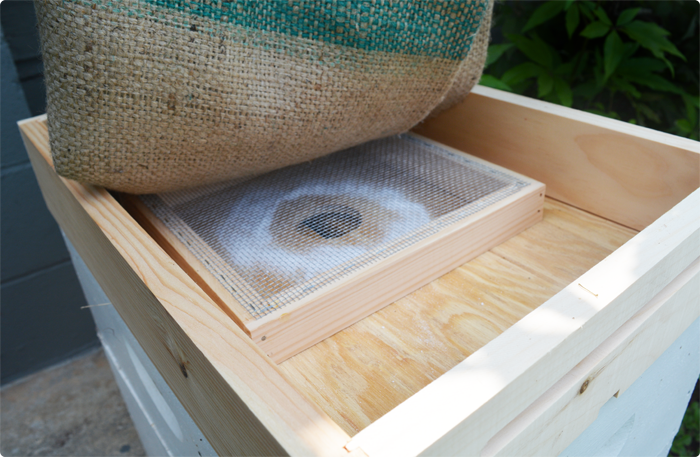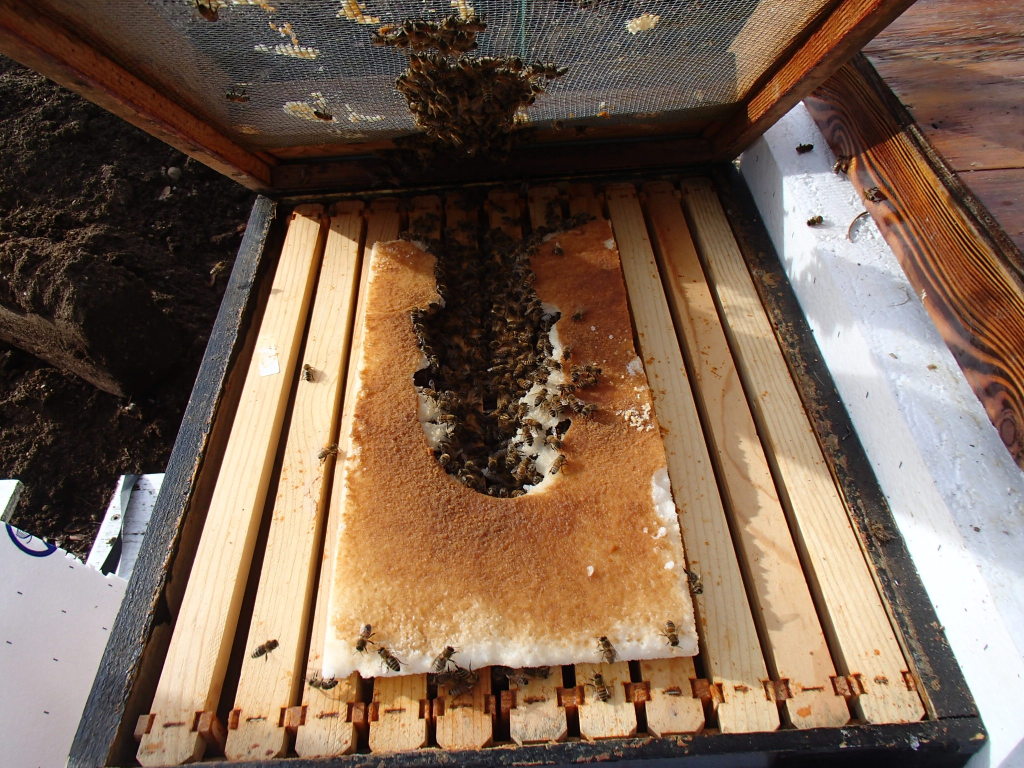After the daytime temperatures fall below about 60 degrees it’s time to stop using a liquid syrup to feed the bees, and to remove any remaining pollen patties from the hive. In our area that generally means early October. Bees don’t take up syrup when it is below 50 degrees, and without enough warm daytime temperatures, they cannot reduce the syrup to honey for storage. The extra moisture in the hive from uncured sugar nectar can cause problems for the bees as we enter winter.
You can feed drivert sugar or Baker’s sugar after it is too cold for liquid syrup feeding. The winter bees eat the sugar, saving the honey to feed the spring bees and the new brood. If they run out of honey resources, the sugar may keep them alive over winter. The drivert sugar will also work to absorb moisture. Drivert (or Baker’s) sugar can be put directly on the inner cover with an Imhrie shim added to increase the space between the inner cover and the top.

Ruhl Bee Supply Vivaldi top with drivert sugar covered by a screened frame with a moisture absorbing burlap sheet.
Some people prefer to use fondant or sugar bricks instead of plain drivert. Google ‘winter candy for bees’ and you will see many recipes for sugar blocks and fondant.
Many recipes use vinegar and citric acid to invert the cane sugar from sucrose to glucose and fructose, but there is debate on whether this is helpful. “Natural nectars are composed of various combinations of these three (sucrose, glucose, and fructose). Bees “invert” the sucrose in nectar into glucose and fructose when they convert nectar into honey. The point is, bees can metabolize all three sugars.“(scientificbeekeeping.com/fat-bees-part-3/)
“honey bees do it (invert sugar) instantaneously, thanks to the enzymes in their saliva. Lots of types of nectar have high levels of sucrose, and honey bees have no issue with this, inverting it without knowing it.” (www.honeybeesuite.com/tag/candy-boards/
However, Randy Oliver has found as yet unpublished research that indicates
… that bees may benefit from having at least part of the sucrose in syrup being inverted into glucose and fructose (High Fructose Corn Syrup (HFCS) is also a source of these simple sugars). As best I can tell, colonies put on weight faster, and winter better on inverted syrup. In a recent (yet unpublished) study by Dr. Brian Johnson at U.C. Davis, package colonies on new foundation were fed either sucrose syrup or Mann Lake’s ProSweet (50:50 sucrose:HFCS). The colonies grew better on the ProSweet. (scientificbeekeeping.com/fat-bees-part-3/)
If you are interested in trying inverted sugar, there is a sugar brick recipe that does not involve cooking at Miller Compound Honey Bees and Agriculture. It involves mixing cane sugar with apple cider vinegar, essential oils, and citric acid. The article includes a good photo based explanation of the process. I’ll reprint the basics here:
25# cane sugar
one quart apple cider vinegar (I use Bragg’s organic – make sure it is not just apple flavored but actually made from apples. )
sprinkle of electrolytes (1/2 teaspoon or less)
1-2 T citric acid (Found in your canning dept)
splash of pro Health or other scented essential oil of choice
- Mix together about 1/3 of the sugar and vinegar at a time in a five gallon bucket with a large drill and paint paddle mixer. If you try to mix it all at once, you will get uneven moisture distribution.
- Mixture will feel very soft, but not wet or sticky.
- Fill a shallow aluminum baking sheet to desired depth with moistened sugar mix. I use one that fits right into my Cabelas food dehydrator. You can use any size pan you want, but be sure your bricks are no taller than your frame extension under your inner cover. (EW Use a pastry roller (or any cylinder) to compress and spread out the sugar in the pan.)
- Here I sprinkled some dry pollen substitute on the bottom of the pan. Don’t do it, it just gets gummy. Sugar will not stick to the pan after it has dried. –
- Be SURE to cut the sugar into block sized before it hardens. You’ll never do it after it’s hard. It takes about 2 weeks sitting out in the unheated greenhouse to harden.
- But will set up and harden in 1-2 days in the food dehydrator at about 130 degrees:
- Place the sugar brick on top of the frames in the top hive box, just under the inner cover.
This and other recipes recommend adding pollen substitute to the sugar, but this is risky. Bees get dysentery if they eat too much solid food and then cannot fly outside to relieve themselves. It may be better to wait until spring and feed only if necessary. After the winter solstice when the bees begin to brood out (and if the bees have no available pollen due to inclement weather in the spring), pollen substitute can be added.
(UPDATE: Lauri Miller’s Sugar Brick Recipe is now my favorite way to supply emergency food during the winter. Simple to make and the bees really take to it. I leave a full super of honey on top of the brood box(es) for the winter, with the sugar brick on the frames above the honey. Generally in our area the bees do not need the sugar, but it is there in case of a long winter, or a cold spring.)
There’s an article on Keeping It Simple with winter feeding here: The Minimalist Guide to Winter Feeding that describes using bags of regular sugar for winter feeding. Instructions on simply placing a bag of sugar on the inner cover can also be found in this BeeSource posting, but based on the comments, you do not really need to prepare the bag of sugar more than creating an opening or two and spritzing the openings with water (perhaps adding some essential oils to get the bees interested.

(I’m trying the ‘bag of sugar’ technique, but am putting the bag on top of the screened frame that I was using to contain both the bees and the drivert. I will update this post with the results. UPDATE – Only one of 5 hives took up the sugar from a bag as pictured, so for me this was not a success. Let me know if you had better luck. EW)

